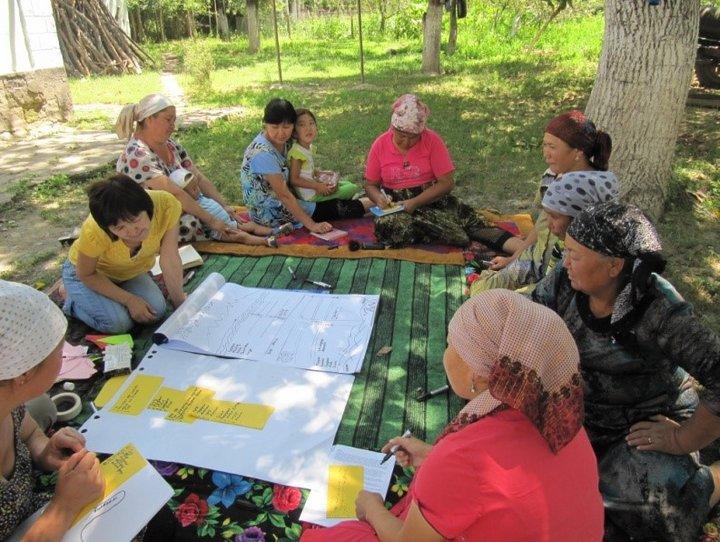Press and News Revealing the benefits of gender-responsive participatory research for sustainable forest management

The special issue of Forests, Trees and Livelihoods explores the prospect of gender-responsive participatory research on forests. The five contributing articles demonstrate that local ecological knowledge is neither homogeneously distributed within communities nor concentrated among socially more powerful groups and participatory methods - when applied in a gender-responsive way - can promote knowledge sharing and inclusive social learning on forests and tree resources.
Sustainable management of natural forest resources requires engaging a diversity of stakeholders who use, manage and benefit from these resources. At the same time, control, access and use of these resources is influenced by gender. Men’s and women’s forest-related knowledge and skills – based on their age, socio-economic status and other social characteristics – shape the way they use and manage tree resources.
In research for development, researchers and practitioners often find it challenging to engage local stakeholders in conservation research and praxis. They have expressed that it is particularly challenging to reach women, thus resulting in research activities that only include the heads of the household – who are often men. Yet, it is essential for researchers to tap into women’s knowledge and experience as they are important collectors and managers of natural resources.
These topics, and many more, are discussed in a special open access issue of Forests, Trees and Livelihoods, which explores the prospects of gender-responsive participatory research on forests. The five articles contributing to the special issue demonstrate that (1) local ecological knowledge is neither homogeneously distributed within communities nor concentrated among socially more powerful groups who, in the absence of a gender-responsive approach, are often the ones selected as research participants, and (2) participatory methods, when applied in a gender-responsive way, can promote knowledge sharing and inclusive social learning on forests and tree resources.
The special issue on Gender-responsive participatory research for social learning and sustainable forest management is the result of a two-year Gender Research Fellowship Programme coordinated by Bioversity International to strengthen capacities in gender-responsive participatory research that can deliver positive social and forest-related outcomes. The programme offered fellowships to three women and two men from Burkina Faso, Cameroon, India, Kyrgyz Republic and Malaysia. Their five research projects used participatory research methods and activities to study women and men’s forest and tree-related knowledge, skills and management practices.
The fellows’ findings show that engaging with women and men from different socio-economic and age groups is essential for capturing a holistic view of the current status of forest species. Dr. Faridah Aini Muhammad and co-authors demonstrate this in an analysis of how knowledge about native fruit trees is distributed within two communities in Sarawak, Malaysia. They found, for example, that elder women had more knowledge about the number of local mango (Mangifera spp.) and rambutan (Nephelium spp.) species and varieties, followed by older men and young men. However, when asked to identify local organizations that provided services to their community, older men could identify several more than the older and younger women and younger men because of their greater interactions with these organizations. The authors’ analysis focused on local perceptions of the participatory research process and tools, which were on the whole considered useful for the community and relatively easy to use.
Similarly, Narasimha Hegde and co-authors show that knowledge about mango, Indian gamboge (Garcinia indica) and Malabar gamboge (Garcinia gummi-gutta) varies between men and women of different ethnic and age groups because of their different experiences and roles in managing these trees. According to the authors, bringing different groups together in the context of participatory research can blur some of the existing boundaries between them and create more unity in forest management. Dr. Marlène Elias and others contextualize this process in the introduction to the special issue, where they suggest that, “when safe spaces for participation are created, opportunities for self-expression and learning from and with others are created, even for marginalized groups”.
Yvonne Kiki Nchanji and co-authors argue that, in their Cameroonian study sites, the use of surveys designed for typically male heads of households fail to reveal adequate information on the production and sale of non-timber forest products since these are primarily managed by women. Various methods and tools—as well as the skills to use these—are needed to carry out gender-responsive participatory research that promotes social inclusion and learning for both men and women. The authors describe the challenges of mastering these tools, particularly among researchers who do not have a background in the social sciences.
Finally, Mawa Karambiri and co-authors show the type of data that can generated by using these methods, comparing the shea tree (Vitellaria paradoxa) ethnovarieties recognized by women and men of different ethnic groups in southwest Burkina Faso. Their findings reaffirm the importance of working with different groups to understand the knowledge and practices that shape forest and agroforestry landscapes.
Together, these new papers illustrate that gender-responsive approaches can offer a holistic view of natural forest resources and lead to better-informed decisions and practices for sustainable and equitable forest management.
Download the Gender-responsive participatory research for social learning and sustainable forest management special issue
Photo: Mapping older women’s forest knowledge in Kyrgyzstan. Credit: Innovation Centre for Phytotechnologies of the Kyrgyz National Academy of Sciences/K. Musuraliev
